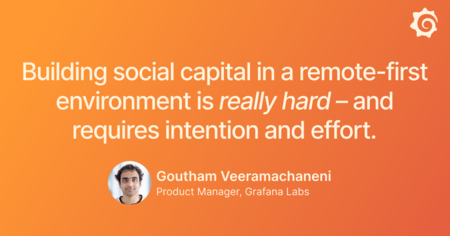
Inside Grafana Labs: Remote-first is relationship-first
Personal connections are essential to work effectively as a team. Teammates need to share a vision, support one another, and show empathy towards each other. This might seem obvious, but it bears repeating — especially now, as we hear more and more about companies facing unexpected shifts in the way they do business and, in turn, how their teams operate.
These personal connections within an organization, which are also known as social capital, are often key to creating an environment in which a team can thrive. But in a remote-first environment like Grafana Labs, where we have more than 900 employees stretched across 40+ countries, they are imperative.
The importance of social capital became especially clear to me when I transitioned into a product manager role in Grafana Labs’ Application Observability department, with a focus on OpenTelemetry and the ingestion pipeline. The role involves a lot of dependencies on several teams across departments. I need to make sure everyone is aligned, and this means talking to several people to make sure they are correctly planning and prioritizing the work my team needs. Relationships have formed automatically within my team, but they don’t necessarily develop as easily across different teams — especially when these teams are also distributed across different regions around the world. This is where social capital comes into play.
What is social capital and why is it important to teams?
I first read about social capital on Rediverge, a subscription-based digital publication written by John O’Nolan, founder of the open source publishing platform Ghost. In a post about social capital in a remote work environment, he wrote:
Working with someone you’ve known your whole life and trust implicitly? That’s a lot of social capital. Throwing together a group of strangers for a hackday? Almost zero. Difficult to quantify, yet incredibly important — and the single most difficult problem in working with a fully-remote team.
Human relationships are a bit like a bank account. You start at $0 on the first day when you meet someone new. Then, each time you interact with them, the balance of the social capital between the two of you either goes up or down. It’s the aggregate representation of trust, goodwill and loyalty which forms the basis of value you ascribe to that relationship.
In other words, without social capital, a team just wouldn’t work.
Imagine you have a lot of work and are slightly underwater. You get two requests: one from your coffee-swap buddy, and another from a complete stranger. You are more likely to prioritize the request from the person you know — meaning, the person you have built social capital with over time.
As mentioned earlier, I recently saw the importance of social capital at Grafana Labs when I started on a team that has a lot of dependencies on other teams. The team’s internal work was progressing quite well, but its cross-team collaboration was subpar. We were opening PRs to other team projects, but sometimes they weren’t getting enough attention. Communication across teams was full of friction and required a lot of coordination and meetings instead of being more freeform over chat. There were even misaligned expectations at one point.
“In addition to cross-team collaboration, social capital is critical for effective collaboration within teams.”
After talking to folks and holding a retrospective, it became clear that cross-team relationships were weak. There was next to no social capital because the team members were new to working together and were only engaging from a work perspective; we didn’t invest the time to get to know each other, personally. This hindered our collaboration. For example, it’s really hard to send a DM to someone you don’t know, especially if they are in a more senior or leadership position. You might feel like you are imposing on them, so you delay reaching out. And yet sometimes, DMs are necessary to clarify a project and move it along.
In addition to cross-team collaboration, social capital is critical for effective collaboration within teams. For example, I have a friend who works at an office-first company that switched to remote work during the pandemic. My friend moved to a different team during the remote period and didn’t know any of her teammates. She never felt a desire to help her teammates. She wasn’t very motivated by the team’s goals. She just stuck to the tasks assigned to her.
Everything changed when she finally met her teammates. Once she started to spend more time with her team socially, she felt like she was a part of the team rather than working apart from them. Now when the team meets every quarter to plan, they allocate enough social time to build social capital with each other.
Building social capital in a remote-first company
Building social capital in an office is easier than building it remotely. Whether it’s watercooler chat or an impromptu post-work gathering, an in-person work environment naturally provides opportunities to socialize and connect. Building social capital in a remote-first environment is really hard — and requires intention and effort.
Remote-first companies can build social capital through in-person offsites. These events are the single best investment for a company with a remote workforce. Grafana Labs has been able to bring people together in various ways, ranging from individual team offsites to company-wide gatherings. After every in-person meeting, there is a clear surge in energy and empathy that then gets recharged at the next offsite.
Of course, not everyone can travel for an entire week. In the cross-team example above, some people couldn’t travel to an in-person meeting due to various personal reasons. But frequent flyer miles are not a requirement for building good relationships with your peers. It’s also not enough to wait for offsites to replenish your capital. Instead, organizations must mindfully help teams build bonds over time, establishing a consistent momentum to encourage connections.
So how do we do that? It’s a tough question to answer, and we have explored different ways a remote company can foster team dynamics. But, in the end, it boils down to being human. Here are five best practices to try:
Make 1:1s personal: 1:1s are the single biggest tool to build social capital. Regularly talk to those you work closely with and make this time a priority. During my 1:1 with Tom Wilkie, CTO at Grafana Labs, he always starts by talking about something outside work. He checks in on me, and asks me how my life is going. For example, in a recent conversation, he asked me how my relationship is going and how my girlfriend is doing. (We’re still doing fine, Tom!) That might seem too personal, but it’s the relationship I have with Tom because of the social capital we have. I am guilty of limiting my meetings to just work, and this is something I am actively trying to change.
Be authentic and vulnerable: My manager during the pandemic was Dee Kitchen, Senior Director of Engineering at Grafana Labs. They built social capital by being vulnerable and sharing deeply personal stories. I was experiencing burn out, but they created a safe space for me so I could be vulnerable and open up, too. This built up a mountain of social capital that still exists, even after two years of working outside Dee’s organization. They showed up for me, so I show up for them. If they ever ask for something, it will immediately go to the top of my to-do list. I am not sure I can emulate Dee, but they set the gold standard for me in building — and maintaining — authentic relationships.
Celebrate wins: Myrle Krantz, Senior Engineering Manager at Grafana Labs, pointed out that we build a lot of social capital when we accomplish goals and ship new features as a team. People feel good about themselves and others when they are proud of what they built together! Celebrate those moments. Maybe after a big launch, send everyone a t-shirt to commemorate the moment. Always acknowledge everyone’s effort and contributions.
Create space for banter: Encourage discussions around common interests. The gamers on the team, for example, can spend the first few minutes of a meeting sharing new games with each other. These casual exchanges are extremely effective in building social capital.
Experiment: Always try to discover new ways to build social capital. For example, I am challenging myself with a few social capital goals:
- Confession: I sometimes skip my scheduled 1:1s because there is nothing to talk about. I am trying to focus on still showing up for these meetings, even in those cases.
- We have Donut, a Slack integration that pairs you with a random employee each week. At some point, I stopped using it, because I never prioritized the time. But I think it’s critical to meet new people and will look into restarting this — and maybe even set up a Donut meeting just for our org.
- My org has a weekly 30-minute Mibo virtual gathering. I have never attended, mainly because it’s not a platform that works for me. But I am committed to try to engage and see if I can make it work. If not, I can tweak things slightly to fit.
- One of the teams at Grafana Labs has a workflow that posts the message below every Monday. I think it’s fun and could be used to seed personal conversations in 1:1s.

Building social capital takes time and effort. And in a fast-paced environment, it may seem like a waste of time. But I hope the above examples show how important it is to build relationships and empathy. I would love to know what works for you or your team!
Thanks to Richard Hartmann, Myrle Krantz and Fabian Stäber for reviewing the draft, providing feedback, and, of course, building social capital through this blog!



